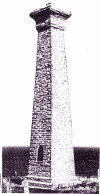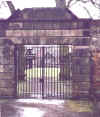|
The
Covenanter Ships –
“Eaglewing”, “Crown”
“Rising Sun” and “Henry & Francis”
The flow
of Scottish migrants to the Province of Ulster who came
in search of land and religious freedom was significant
in the Plantation of Ireland.
 Yet, Yet,
in a short space of 20 years there was a change in the
relationships with the government in Dublin:
particularly after 1633 when Thomas Wentworth, later
Earl of Strafford, became the Lord Deputy in Ireland,
and when Archbishop Laud enforced the Bishop’s rule and
implemented many Catholic practices in the established
Anglican Church of Ireland.
The Scots
had tried hard to fit in at the start but friction was
continuing in Scotland with resentment to the religious
policies of James I (James VI of Scotland) and his
successor Charles I. There was also the fervour of
evangelical groups, especially the Covenanters, that
added friction to the Presbyterian communities in both
Scotland and Ulster. The thoughts of a few turned to the
possibility of joining the exodus to Massachusetts, but
whether the impetus came from Scotland (where as early
as 1630 there had been discussions about migration) or
from Ulster is uncertain .
A group
of Planters and the Presbyterian ministers John
Livingston, Robert Blair and Robert Cunningham agreed in
1634 to seek information from the Massachusetts settlers
about the prospect of acquiring land and the freedoms
they desired. Letters were sent to John Winthrop, the
governor and seemingly encouraging replies were received
as some Planter families prepared to leave for the
Colonies.
“Eaglewing”
Into the
scenario came John Winthrop, the son of the Governor who
had been to Trinity College, Dublin in 1622-1623. He
returned to England in 1635 to purchase livestock to be
sent to the colony and is known to have visited Scotland
where he had contact with Provost
John Stewart in Ayr, David Dickson in Irvine and James
Murray in Edinburgh. In Ulster one of his contacts was
the affluent settler, Sir John Clotworthy. The
Clotworthy family had prospered under James I and
amongst other things had been granted the licence to
sell wine and spirits in most of County Antrim and
County Down; it is likely that their wealth supported
the planned migration. Sir John wrote to Wentworth that
a ship was being built and he was anxious that the
migrant party should get under way as soon as possible
(as he feared action would be taken to prevent future
migration). The ship was the “Eaglewing” its name coming
from Exodus Ch 14 v 4
“Ye
have seen what I did to the Egyptians, and how I bare
you on eagles’ wings and brought you unto myself “.
The
building of the ship got under way at the small village
of Groomsport on the shore of Belfast Lough and it was
not until the autumn of 1636 before it was ready. At 150
tons the “Eaglewing” was barely big enough for the 140
passengers who had gathered together to face the dangers
of the seas in this small craft. Although stoutly built,
the “Eaglewing” was untried in the rough seas that it
was to encounter following its departure from
Carrickfergus on September 9, 1636. Difficult winds
drove the ship into Loch Ryan almost before it had
cleared the harbour but at length they set sail once
more. John Livingston, minister at Killinchy, who had
been at the heart of the migration plans, was to say
afterwards that the ship was three or four hundred
leagues from Ireland when it was hit by turbulent seas
and a hurricane that broke the ships rudder: heavy seas
broke over the vessel and poured down into the cabins
and the hold. The rudder was repaired but the ministers
and the passengers aboard held a meeting and concluded
that it was God’s will that they should return to
Ireland. On November 3, the ship arrived back in Belfast
Lough. John
Livingstone`s recollections
were of quite horrendous conditions with an imminent
danger of capsizing.
The
Scottish passengers returned home and the Ulster Scots
having previously sold their possessions, sought with
difficulty to pick up the threads of their former life.
There was no further attempt to make the trip to New
England. The embarrassment of failure was felt by the
ministers no doubt and they were subject of some
scathing criticism – “their faith not being answerable
to their zeal” as the Bishop of Derry wrote to the arch
persecutor Archbishop Laud.
The
failure of the expedition also meant that these strong
willed Scots were able to bring their influence to bear
in subsequent events in Scotland. Amongst these were
John Livingston, and Robert Blair, a minister of
Calvinist leanings at Bangor, who was largely
responsible for a revival of the Presbyterian church in
County Antrim and County Down. They and others, such as
Robert Cunningham minister of Holywood, eventually fled
to Scotland to escape the persecution of Strafford. It
meant that these staunch supporters of Presbyterianism
were present to add their respected voices to the
National Covenant of 1638.
There
was, however, a sweet revenge in many ways as Sir John
Clotworthy was to play a part in the impeachment of the
Earl of Strafford who was subsequently executed at the
Tower of London in 1641.
“Crown”
The
second of the Covenanting ships in this tale to set out
with Covenanters aboard was the “Crown”.
In
Scotland there was increasing dissent and Covenanting
fervour was bloodily persecuted especially in
years from 1679 – 1689 and in “The Killing Time”
when so many were executed or shot out of hand during
1684 -5.
Following the Battle of
Bothwell Brig on June
22, 1679, some 1200 prisoners were taken and
incarcerated in a make shift, open air prison next to
the Greyfriars Kirk in Edinburgh. Of these prisoners,
257 erstwhile ringleaders and ministers were sentenced
to be transported to the West Indies or Virginia as
white slaves.
The
vessel set sail on November 27, 1679, but within days
was forced by bad weather into the Orkney port of
Deersound where despite local advice, she set out once
more into the deep swells of the
 Atlantic Atlantic
Ocean. The ship had hardly cleared land when she struck
rocks off of Deerness and was wrecked. It is said that
the captain was a heartless and cruel man and despite
the pleas of the frightened prisoners he ordered the
hatches to be chained. Thus it was on December 10, 1679,
that 211 Covenanters went to a watery grave. The crew
escaped by cutting down a mast and using it as a bridge
to the shore but prisoners who tried to do the same were
forced back into the foaming sea. A mere 49 Covenanters
survived the wreck only to be transported later.
There is
a slight problem with the numbers as the
Cloud of
Witnesses, the main source of
information, lists 49 survivors, thus 208 perished
assuming the 257 total was right in the first place.
There was at least one late attempt to save one of the
prisoners and some relatives volunteered to take the
place of others. A
magnificent granite memorial stands at Deerness
commemorating the sad event.
“Rising Sun “
The
“Rising Sun” was a a vessel of sixty guns, captained by
James Gibson, whose brother William was a merchant and
bailie in Glasgow. On 27 May 1684 an act was passed by
the Council granting prisoners to William Gibson for
transportation to America ( probably Carolina – a
favourite destination). On 19 June a report was made to
the Council by Sir William Paterson that twenty two
prisoners were to be removed from Glasgow Tolbooth. As
far as can be ascertained their crime was the usual –
refusing to recognise the king`s supremacy and they
would not renounce the Covanents. Twenty one of
their number subscribed to a joint testimony and are
named by Wodrow as :
Matthew
MACHAN; James M`CLINTOCK ; John GIBSON ; Gavin BLACK ;
John PATON ; William INGLIS ; John YOUNG ; John GALT;
John EDWARDS ; Thomas MARSHAL ; George SMITH ; William
SMITH ; Robert URIE ; John BUCHANAN ; Thomas BRICE ;
John SIMON ;Hugh SIMON ; William SIMON ; Archibald
CUNNINGHAM ; John ALEXANDER ; John MARSHAL
The
Rising Sun was one of the ships that took settlers to
the ill fated Darien expedition in Panama. When the
settlement broke up the Rising Sun set off
homeward and had reached the Gulf of Florida when
she was smashed up in a violent storm, that took away
the masts. The crew struggled for ten days with a jury
rig before reaching Charleston where she lay at anchor
pending her guns being removed so that the vessel could
get over the bar. But a hurricane struck on 3 September 1700 and the ship and all her crew were lost.
Among the crew lost was a young Hugh Litster, son of Thomas Litster,
minister of Aberdour.
It is
reported that Captain Gibson was an extremely cruel
person. Their daily water ration was a mutchkin (
less than an English pint ) and an ounce and a quarter
of salt beef. It is difficult to conceive of such
pettiness; but someone had to measure the rations and
cut up and weigh the tiny meat allocation each day and
to do so meticulously else they joined the prisoners.
That Gibson and his ship was lost can be seen as a just
reward for the cruelty towards his fellow man.
“Henry
& Francis”
 It It
was the practice to commit dissenters, those who refused
to take an Oath of Allegiance or recognise the King`s
authority, to be imprisoned but there were so many that
a policy evolved whereby Covenanters could migrate to
the American colonies. If, however, they were convicted
they were sent as slaves. The laird of Pitlochie, John
Scott, was allowed by a warrant dated 10 March
1685 to select a party of about 100 prisoners to
take with him to New Jersey. He was required to land the
party in America before September 1686. For this purpose
Scott chartered a 350 ton ship, armed with 20 cannon,
called the “Henry and Francis” captained by a Richard
Hutton. Pitlochie visited the prisons of
Edinburgh, Glasgow and Sterling and also Dunnottar from
where he selected about thirty prisoners. Among these
was Patrick Walker, a well known author also
known as Patrick the Pedlar, who managed to escape while
the ship was hove to in Leith. This
list is from a mixture of sources and there
are one or two name variations.
There
were other migrants who were required to pay £5 passage
money but they could alternatively be indentured
servants for four years after which they would receive
25 acres of land. The ship set sail on September 5,
1685, from Leith and made landfall at Perth Amboy, New
Jersey, in December. It was a traumatic journey with the
ship suffering leaks, shortages of food and water, as
well as fever especially among the Dunnottar prisoners
who were already much weakened by their imprisonment.
Of the 125 souls on the ship that set out some 31 of
their number died, including Scott and his wife. During
the voyage, Scott’s son-in-law (named John Johnstone)
had urged the prisoners to accept a four year servitude
so that the costs of the venture could be recovered,
which the prisoners resisted. The ship’s master wanted
to sail for Jamaica or Virginia since a better price
would be obtained in either place for the prisoners.
Perhaps it was Providence intervening for these
Covenanters, but a change of wind forced the ship into
New Jersey as originally planned.
The
arrival of the prisoners was not apparently welcomed by
the residents and it was left to people further in land
(thought to be Woodridge) to extend the hand of
friendship. The prisoners were given clothing and
sustenance and taken in. In the New Year Johnstone, a
mercenary man, sought to recover the costs of the
exercise in the courts, which could have resulted in the
imprisonment and probable slavery of the
ex-prisoners. They were, however, cleared of charges by
a jury because they had not come voluntarily nor had
they entered into any agreements. Thus the fortunate
survivors went their ways – scattered throughout
Pennsylvania, New York and Connecticut succeeding where
their earlier compatriots had failed.
Next :
Covenanter Tales
|